How To Tell If A Palm Tree Is Dead, Dying or Sick?
Look out for these symptoms in your palm: Wilting, crown turning brown, pests infestation, or most importantly no new growth. These all could be alarming signs that your tree is dying or dead.

Even the most majestic palm tree is susceptible to nutritional deficiencies, pests, diseases, eventually leading to death. Did you ever ponder whether your palm tree is in danger of dying or if there is anything you can do to save your palms?
Remember there could be a possibility that your tree is already dead. All your efforts to save them would go in vain if the tree is already dead from the inside. So, how to tell if a palm tree is dead?
Some tell-e-tale signs of a dying palm tree include younger fronds falling off or turning brown, yellow, or wilted. Other things you must notice are whether the tree’s center is becoming brown or if there are any holes in the trunks from unmonitored diseases or pests.
Given their massive size, removing a dead tree can be tricky, and you might need a professional’s intervention. So, be proactive and do not let such an event occur. Read below as we discuss some signs of a dying palm tree and what you can do to save them.
How To Know If A Palm Tree Is Dying?
Some giveaway signs include discolored center and fronds, trunks filled with holes, and problems around the tree’s base.
Your palms may die because of multiple different reasons – they may not receive adequate direct, bright sunlight, lack enough space for the palm roots to spread, or are overwatered. At times, emerging pests, and diseases might also ravage palm trees.
So, if you spot early warning signs, you must take proactive measures to revive the plant and avoid future issues.
Read below as we discuss the signs in detail:
A. Wilting Leaves
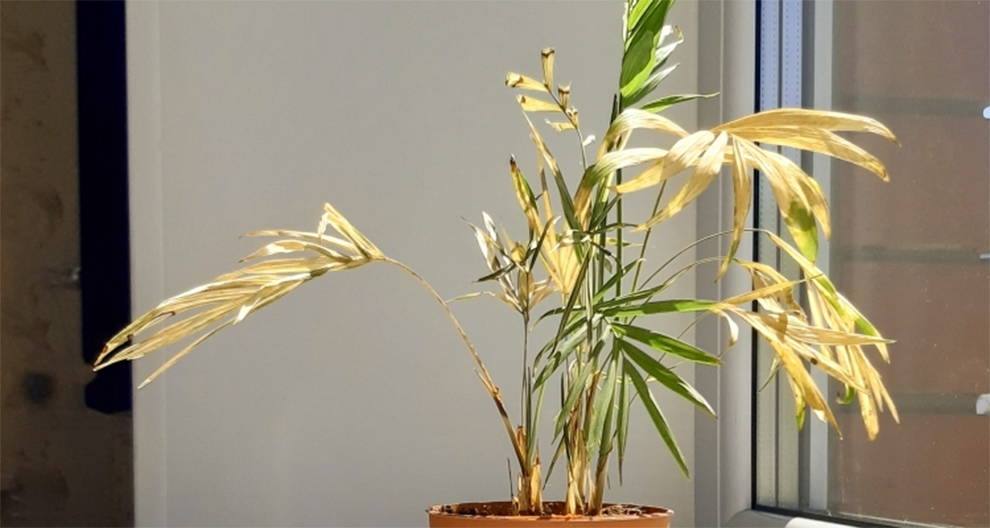
Examine the fronds and check for signs of wilting or discoloration. This is the first thing we suggest when somebody asks us how do I know if my palm tree is dead.
If the fronds limp or drop toward the ground instead of standing up firmly, your tree is unwell. However, wilting straightaway does not mean your tree is dead. But it may signify something is wrong.
At times, wilted leaves mean that your palm is thirsty. But if the leaves are badly wilted, and the tree has adequate water available, it means that the palm cannot absorb the water or is probably dying.
B. Changing color
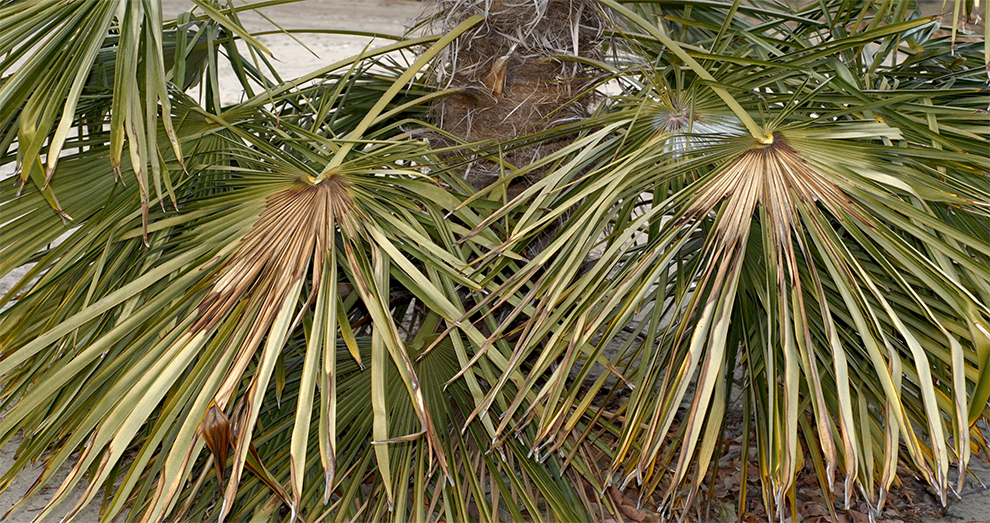
Even though it is normal for the fronds to age and change color from green to orange and eventually brown, the younger fronds should always be bright green. So if all the fronds including new growth are curling or turning brown or yellow, you are not giving them enough water.
Other issues like diseases, stress, and nutrient imbalance might also result in discoloration. All of this may signify that your plant is probably dying.
Generally speaking, yellow leaves mean the plant has some life but is unwell. However, if the leaves have turned brown, curled up, or lost their flexibility, the plant has no chlorophyll or sap remaining in the fronds and has probably died.
So, remove the damaged foliage, but if you see no new healthy growth, your palm will not grow further.
C. Leaf loss
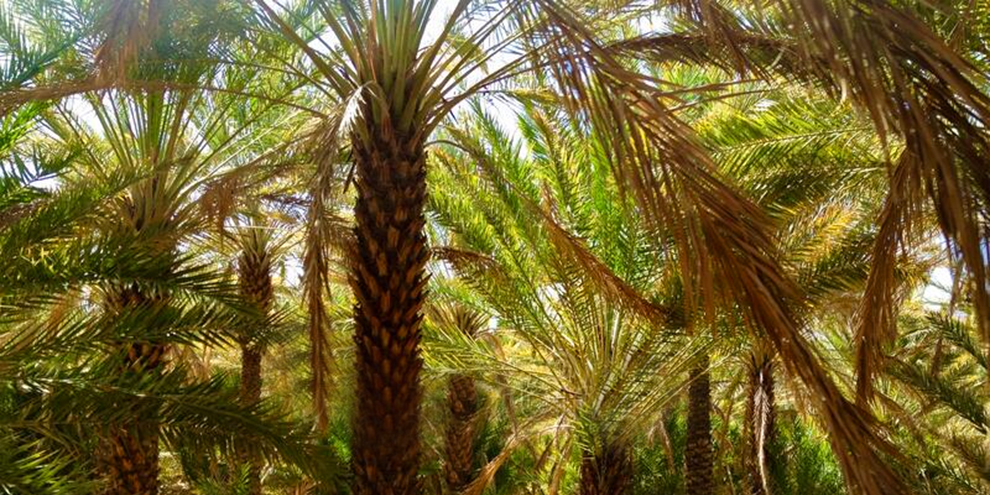
At times, the palm may drop the fronds. One or two fronds falling at a time is normal, but something is wrong if the palm is shedding more than usual. In a dying/dead palm tree, you will see most or all of the fronds falling off. However, the process usually takes several months, especially if you have a mature tree.
D. No new growth or young fronds dropping off
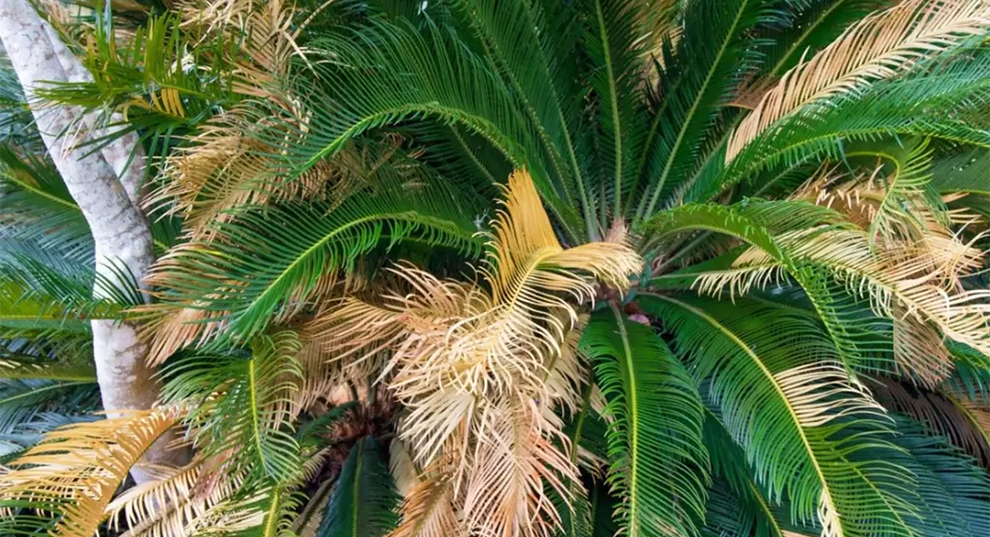
If the tree recently sprouted but lost its new growth, it is either very sick or dead. It is unlikely for the new foliage to fall off from the healthy tree as the plant dedicates most of its energy towards leaf growth.
Hence, it does not drop its leaves unless the tree is sick. While some stop showing new growth, meaning the tree has no fresh leaves to drop, others produce and then shed their new foliage. Regardless, it means the plant is either dead or may die soon.
E. Major pest attack
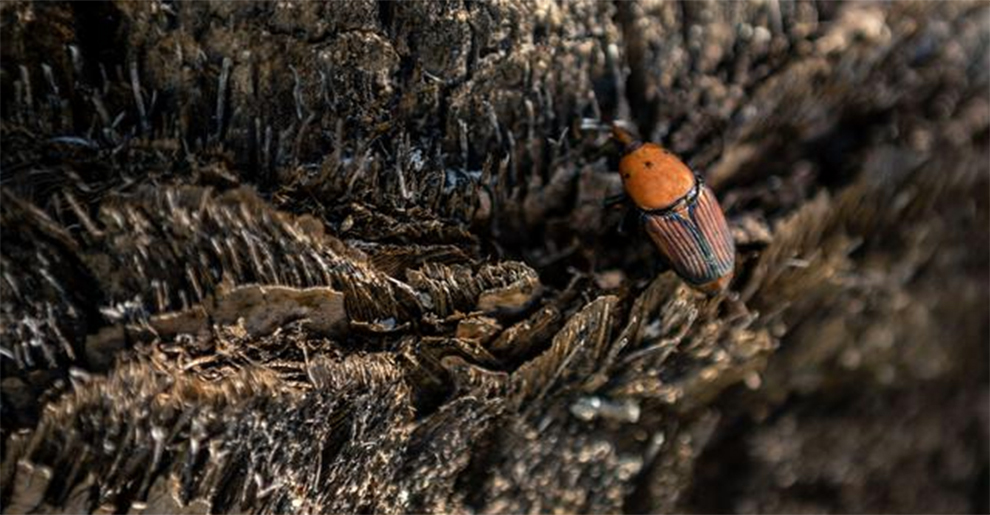
A pest attack can kill your palm tree. So if you spot several pests crowding the palm tree, the palm has severe concerns and no resilience to combat. Hence, you must act immediately.
Pests might even hang on the palm that has died, but the kind of pests will differ. On a dead palm, you can find insects that thrive on healthy plant matter, such as aphids that drink the sap, crawling out.
On the contrary, those that eat decaying matter will move in on a dead tree. So check the kind of pests you see to know whether the palm is dead or alive.
F. Wounded trunk
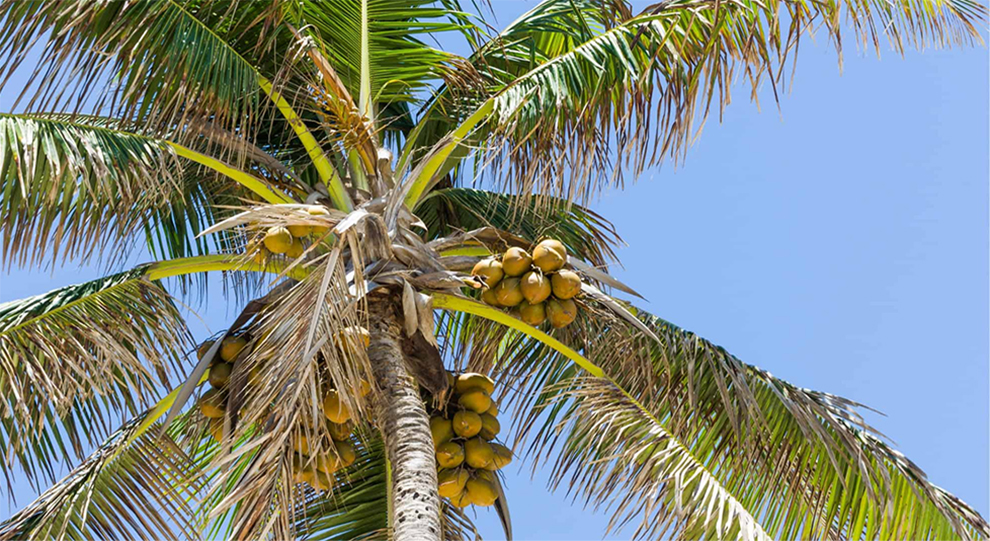
You may not want to cut open your palm tree, but it is indeed one of the fool-proof ways to assess whether your palm is alive if it looks very sick.
While doing so, use a sterile, sharp knife to avoid spreading the disease into the trunk. Be cautious and cut a short way into the tree’s tissues and peel the outer layer to see the plant’s inside.
If you spot any greenery inside, the plant is still alive, and it may be salvageable. But if there is no greenery, the tree is probably dead.
G. The crown turning brown
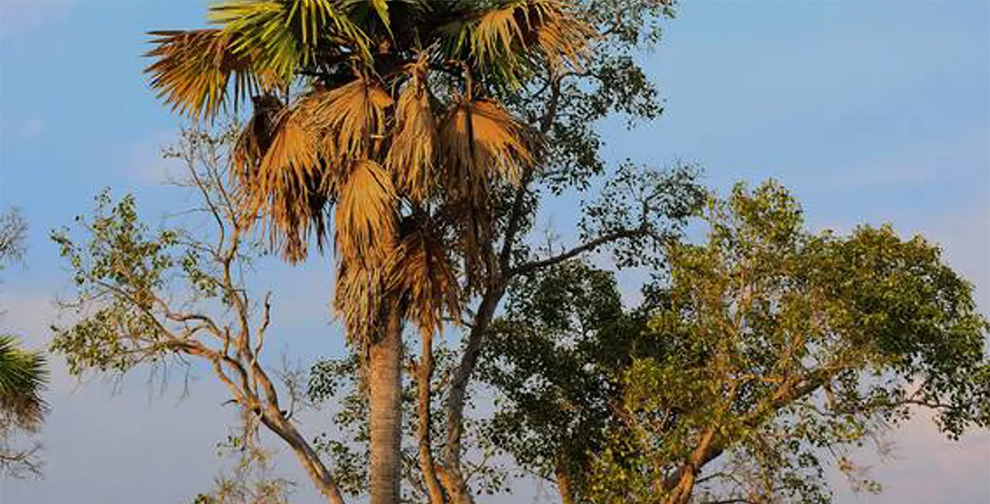
Depending on the palm tree species you are growing, you might be unable to see the tree’s crown from the ground. But if it is visible, it can be an excellent way to determine whether the tree is living.
The crown sits on the palm’s top and lies in the center. It is the point from where the leaves grow. The tree is dead when the crown has turned brown. The plant won’t be able to yield fresh leaves if the crown is dead, and eventually, all the live parts will also die.
H. A tilting tree
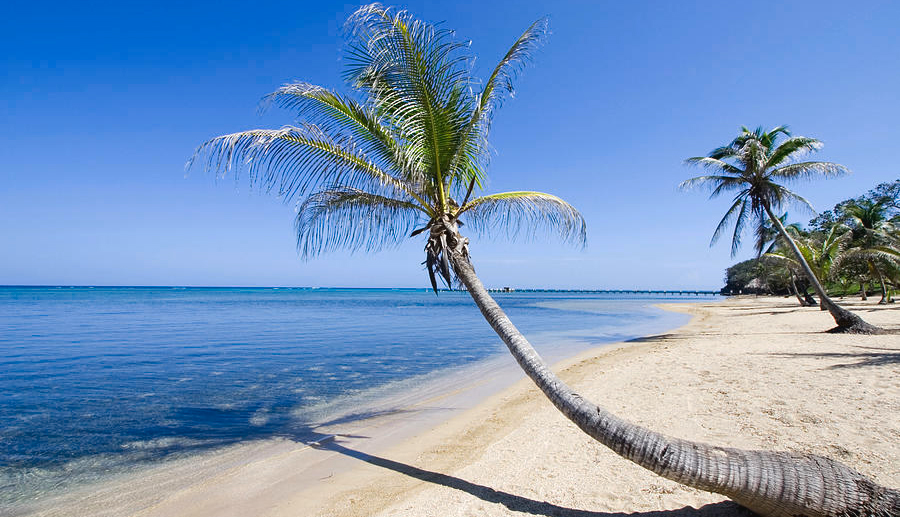
A dead palm tree can stand for several months to several years before falling or tilting, depending on various factors such as the palm species, weather conditions, and the surrounding environment.
Some palm species are more prone to falling when they die than others. For example, coconut palms have shallow root systems and are likely to fall over when they die. On the other hand, date palms have deeper root systems and are less likely to fall over.
Weather conditions can also determine how long will a dead palm tree stand. High winds or heavy rains can weaken the already weakened structure of a dead palm tree, making it more likely to fall or tilt.
The surrounding environment can also impact how long a dead palm tree will stand. For instance, the authorities will sooner rather than later remove the palm tree in a high-traffic area, such as a park or street, for safety reasons. In contrast, it may be left to stand until it falls on its own if it is in a remote location.
In general, if the plant starts tilting or drooping, it is possibly dead, and it is best to have a dead palm tree removed as soon as possible to prevent any potential hazards.
Why Does A Palm Tree Die Before Completing Its Lifespan?
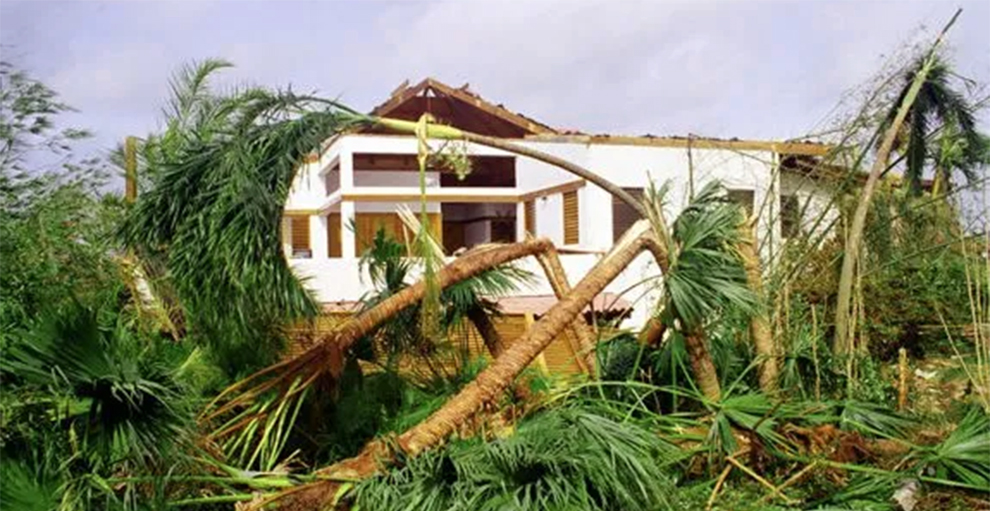
Typically, palm trees have a good long lifespan. Some reasons why they die prematurely before completing their lifespan are as follows:
1. Human activity – At times, palm trees are killed or harmed by human activity like landscaping or construction projects that damage the tree’s trunk or roots.
2. Pests – Palm trees are susceptible to various pests like fungi, mites, and insects. These can cause severe damage to the tree’s roots, trunks, and leaves and eventually kill the plant.
3. Disease – Like every other plant, palm trees are vulnerable to disorders that hamper their health and growth rate. Some such diseases are fatal for the plant if not caught early, resulting in the plant’s death.
4. Environmental stress – Palm trees are susceptible to environmental changes, such as water availability, soil conditions, humidity, and temperature. When exposed to prolonged stress, it might be unable to recover and eventually die.
5. Other reasons include improper palm care, unsuitable soil, overwatering or underwatering.
Can A Dead Palm Tree Come Back To Life?
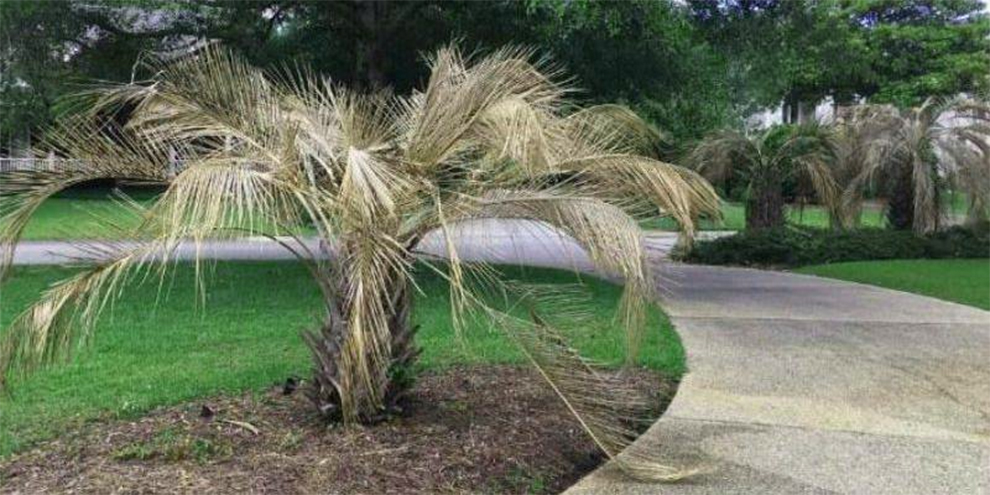
You have learned how to tell if a palm tree is dead. So if the tree has died, it is unlikely for it to come back to life. Unlike most plants, palm trees do not have regenerative structures or dormant buds that allow them to grow back from damaged or dead tissue.
But in some situations, the palm tree may look dead but has some life left in it. For instance, if its leaves have dried out and are brown, it may be a sign of damage or stress, but the tree may still be alive at its core.
In such instances, it may be possible for you to revive the palm tree by simply addressing the underlying issue. So, if the tree is not getting ample water, throw water into the soil around the base to help it recover.
Likewise, if the plant has undergone a pest infestation or is suffering from a nutrient deficiency, address these issues, and you can fill your palm with life again. But if the palm is dead, no care and attention can bring it back to life. Hence, you must remove the dead tree and plant a new one on its site.
How Do You Bring A Dying Palm Tree Back To Life?
You already know what does a sick palm tree look like, so anytime your plant looks unwell, you do not want to delay remedial action. Here are the steps you must take to bring a dying palm back to life:
1. Inspect and examine the problem – The first step towards reviving the palm tree is identifying the problem causing its decline. Some common issues include nutrient deficiencies, underwatering, overwatering, diseases, and pest infestation.
2. Alter the watering schedule – If watering is the reason, you must make amends in the watering habits. Generally if the soil enveloping the tree feels too dry, water more frequently. On the contrary, reduce the watering frequency if the soil is waterlogged.
3. Improve drainage – If the soil is not well-draining, it can result in root rot and other issues. So, adding organic matter to the soil or forming a raised bed can help with drainage.
4. Control pests – Palm trees are susceptible to different pests, such as mealybugs, scale insects, and spider mites. So, if you find these pests on palm trees, you must take immediate action to treat them with an insecticide.
5. Address nutrient deficiencies – Palm trees desire specific nutrients like potassium, nitrogen, and magnesium. Its leaves may turn brown or yellow if you do not feed the plant enough nutrients. Consider adding a slow-release fertilizer designed for the palm trees to make up for these deficiencies.
6. Prune the damaged or dead fronds – Chopping the damaged or dead fronds can help maintain the plant’s aesthetic appeal and help with the recovery by reducing the stress on the tree.
7. Be patient – Usually, it will take a couple of months or weeks to see the improvements in the plant’s health. So, keep at it and be patient. However, continue to monitor the progress and make changes as needed.
But if you do not know how to bring your palm tree back to life or if it looks severely damaged, consider speaking to a landscaper or professional arborist for assistance.
Related: How to protect palm trees in winter?|White spots on Palm tree leaves
What To Do With A Dead Palm Tree?
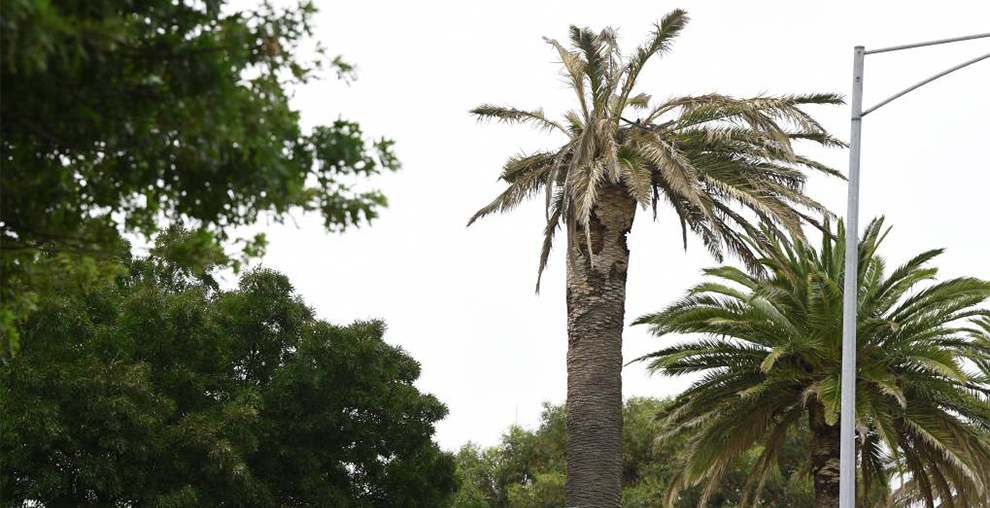
There are simple signs how can you tell if a palm tree is dead, so if this is the case with your tree, you must remove it as soon as possible. This is to avoid further damage or safety hazard to the surrounding property. Here are some options of what you can do with a dead tree for you to consider:
1. Hire a professional – If the tree is difficult to access, is extremely large, or poses some safety hazard, consider hiring a professional for its safe removal.
2. Cut down the tree yourself – If you have the experience and the tools, consider cutting the tree yourself. Please ensure that you follow safety guidelines and wear protective gear.
3. Use the wood – If you have some use for the wood, you can chop the tree into pieces and use its wood for firewood or any other purposes.
4. Recycle the tree – Some municipalities have a tree recycling program wherein the tree can be chipped into mulch or employed for other purposes.
5. Dispose of the tree – If you have no use for palm, consider disposing of it by taking it to a local landfill. Alternatively, you can contact the local waste management service for its pickup.
Please note it is essential to dispose of the dead palm trees properly to avoid any damage or safety hazards to the surrounding property.
